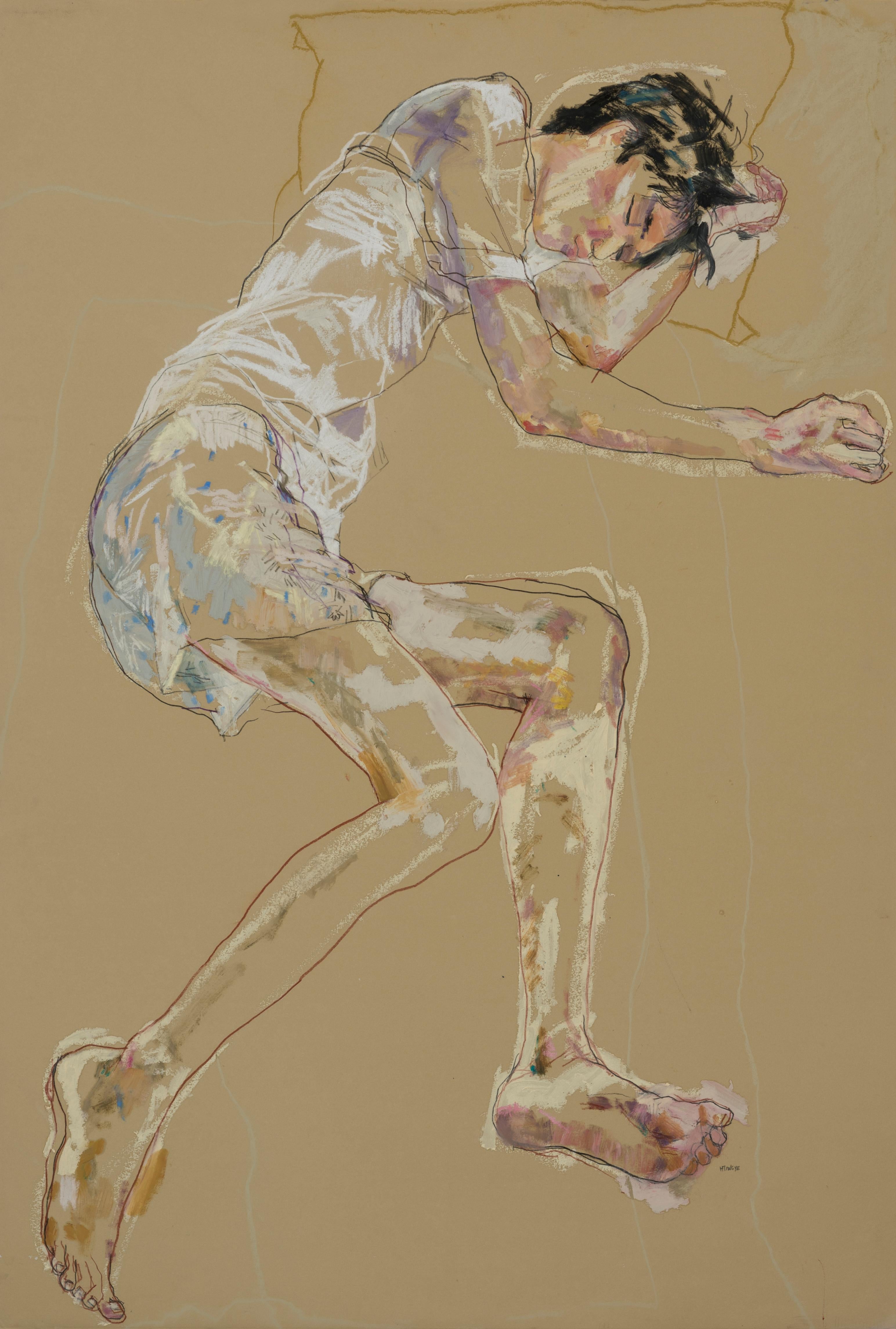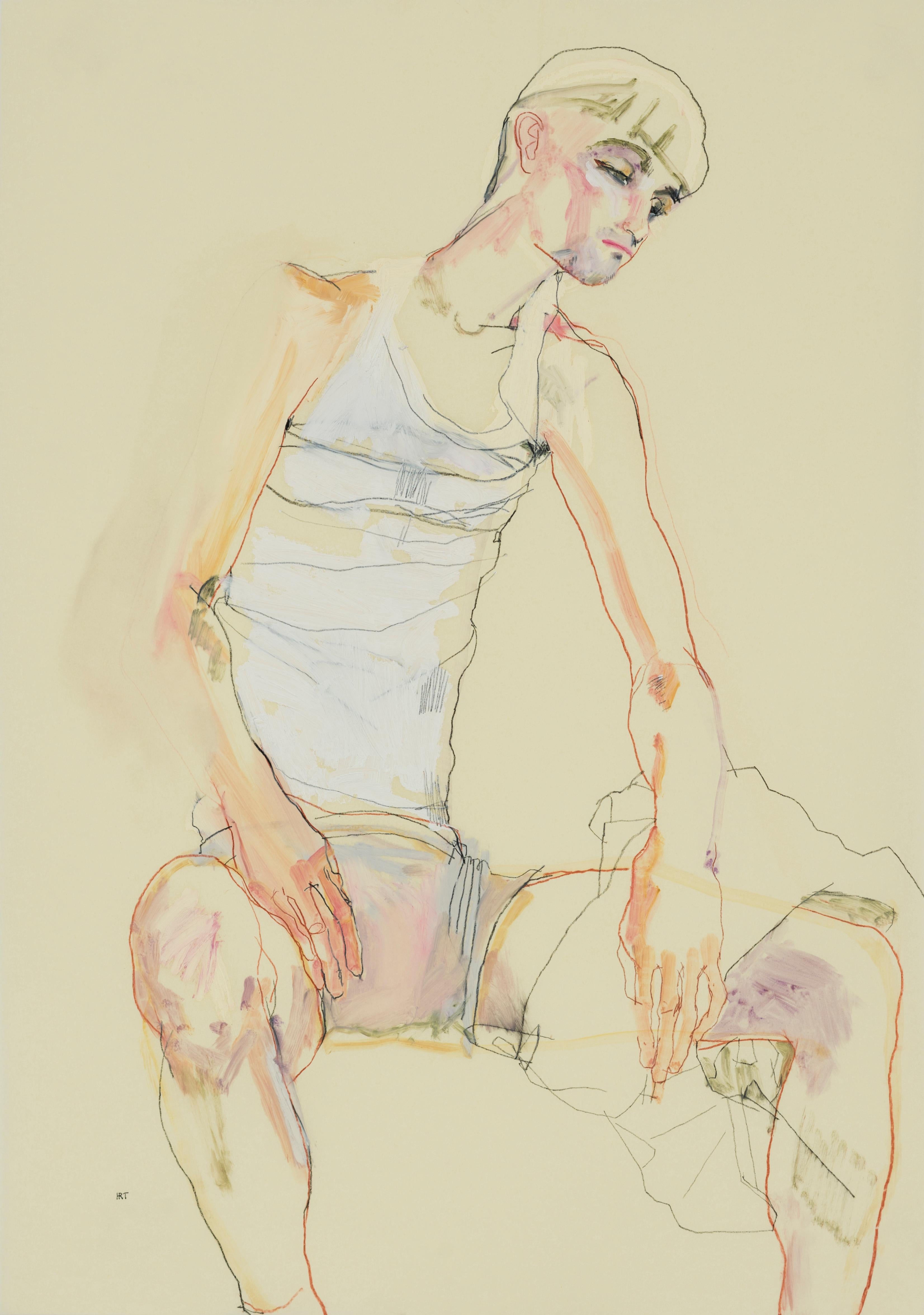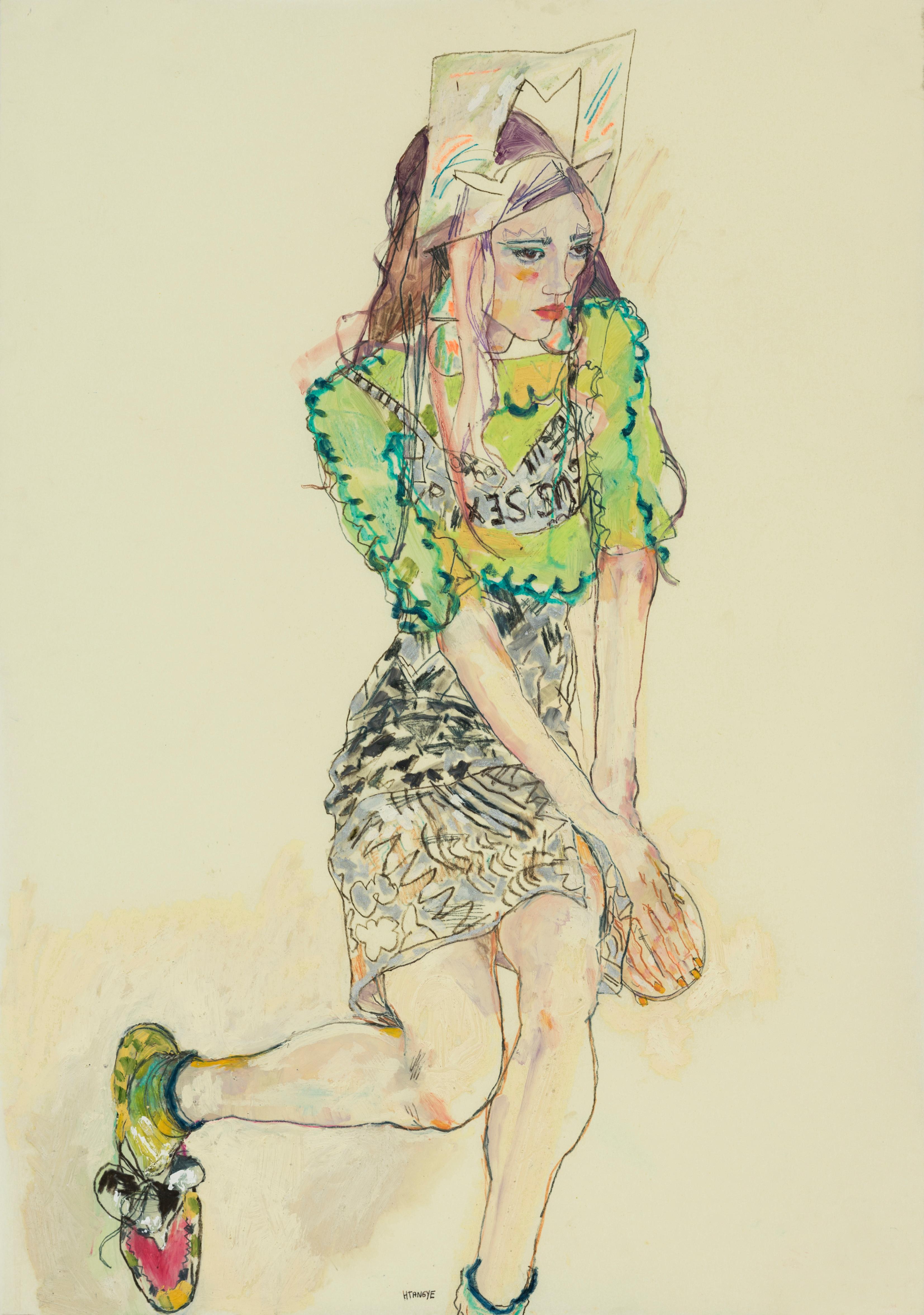Items Similar to Surrealist Gouache and Watercolour on Paper, 'Sunday School Ghosts'.
Video Loading
Want more images or videos?
Request additional images or videos from the seller
1 of 20
Derek Carruthers Surrealist Gouache and Watercolour on Paper, 'Sunday School Ghosts'. 2016
2016
About the Item
Surrealist watercolour and gouache on handmade paper by British artist Derek Carruthers. Signed bottom right and signed, dated and titled 'Sunday School Ghosts' to the reverse.
A wonderfully playful, colourful and energetic painting, cleverly composed of faceless ghostly figures dressed in white emerging from a background of beautiful green. The composition, in the way the figures are posed, is reminiscent of Chinese ancestor paintings especially with the added colourful parasols. The figures are faceless perhaps to make the point that we lose our identity when following any group doctrine.
These figures (reminiscent of artist's lay figures) featured often in this period of the artist's work. An artist lay figure is a doll-like model of the human figure that artists can pose in different ways. It can be used for sketching or as a stand-in for the living subject of a portrait.
"I was given an antique artist’s lay figure and acquired several smaller faceless wooden lay figures. I knew Man Ray’s “Mr. and Mrs. Woodman” series of photographs and enjoyed the irony and humour." So began the series of figure compositions which seem to sustain themselves as symbol and metaphor for aspects of the human condition.
These figures have inhabited Carruthers’ paintings since the early 1990s. They may be placed in a fully-realised 3-D space, their solidity asserted with dramatic lighting; or they may be flat, insubstantial. They may be gathered as a busy community or they may be isolated. They are always featureless. They can be translated as a deliberately ironic comment on life; they are also evidence of the artist’s continuing preoccupation with abstraction. He reduces and manipulates the figures so that they are sometimes in the Romantic tradition, a model of profound humanity, and sometimes - more challenging and chilling - Orwellian tokens of inhumanity.
Derek Carruthers was an artist who persisted in asking questions. His whole career was inspired by the determination to enquire into the nature of art, examine its purpose, and attempt to explore that place where the individual life of the mind meets the external appearance of the world where personal sensation rubs up against cultural assumptions. Not surprisingly, Carruthers explored, over the years, a language of pure form, abstract space, 2 and 3 dimensions, narrative and concept, personal and universal figuration. Looking back, over decades of work, however, each of these voices is pursuing a coherent set of questions, reflecting on the stuff of human experience. Carrthuers’ individual pieces can intrigue and charm, they can be warm and poetic and they can also offer gritty resistance to the easy gaze. They can challenge us to think about ourselves, our environment, our expectations, our place in the world.
Carruthers grew up in the north-west of England having been born in Penrith, and one of his earliest memories of what art might be was formed by his encounter with the extraordinary creations of Kurt Schwitters. The latter had fled Germany in 1937, after his art had been labelled ‘degenerate’. He stayed, first, in Norway and then arrived in Britain in 1940. Carruthers had already encountered Schwitters' work as a boy, and had been launched on his own life-long examination of the nature of art.
Carruthers was further inspired by Victor Pasmore and Hamilton (British Constructivists) who were working closely together at King’s College London and eventually offered a challenging course to all first year students. Thus, Carruthers – who was at King’s in 1953 to 1957 was encouraged to take a rigorous approach to probing abstraction, spatial relationships, and the interlinking of art and architecture.
Having had the good fortune to have been an art student at such a time and in such a place, it is not surprising that Carruthers embarked on a voyage of artistic discovery. He showed his works with the major touring exhibition, organised by the Arts Council, in 1963, ‘Construction England’, together with Pasmore and Mary and Kenneth Martin.
His work was also included in exhibitions of new art at the Drian Galleries, Porchester Place, in 1963 to 1965. Reflecting the more recent re-examination of post-War, British Constructivism, Carruthers’ work was also included in the 1992 show, ‘British Abstract Art of the 50s and 60s’, held at the Belgrave Gallery. This early work, in which solid or relief forms change their nature as they – or the viewers – move through space and time, deliberately challenges the human tendency to find comfort in regarding the world as fixed and knowable.
In these years, too, Carruthers taught at Sunderland and Leicester Colleges of Art, before moving to lead the Fine Art course, as a Professor, at Trent Polytechnic (now the Nottingham Trent University). He was a dedicated educator, leaving to pursue his own art, full time, only in the mid 1980s.
Inspired, perhaps, by this freedom, the 1980s saw Carruthers exploring new ideas. He turned from working in 3-dimensions, or collage and relief, and rediscovered the power of traditional materials, oil and watercolour, on canvas and paper. He moved away from Non-Objectivity towards a practice which explored both abstracted and figurative imagery. Throughout, he remained preoccupied with exploring the human condition: by this trite remark, we mean that he continued to question how each individual experiences the world; he explored the ways in which human beings create totems to make their mark, as if to claim immortality; he tries to, ‘symbolise the triangular relationship between humankind and religion and the art / architecture which it inspires’. Hence - as well as warm glimpses of holidays and home life - his work yields the Egyptian pyramid, the Graeco-Roman heroic figure, the Christian monument; and, ultimately, the ‘sexless, ageless, raceless anonymity’ of the artist’s lay figure.
Derek Carruthers continued to ask questions, both about his life in a particular time and place, and about the lot of the human being on a universal scale. As an artist and a scholar, he saw himself at the intersection of these challenging states. And he makes you think........
- Creator:Derek Carruthers
- Creation Year:2016
- Dimensions:Height: 22.45 in (57 cm)Width: 29.93 in (76 cm)Depth: 0.08 in (2 mm)
- Medium:
- Movement & Style:
- Period:
- Condition:
- Gallery Location:Cotignac, FR
- Reference Number:
About the Seller
5.0
Platinum Seller
These expertly vetted sellers are 1stDibs' most experienced sellers and are rated highest by our customers.
Established in 2000
1stDibs seller since 2020
157 sales on 1stDibs
Typical response time: 1 hour
- ShippingRetrieving quote...Ships From: Cotignac, France
- Return PolicyA return for this item may be initiated within 3 days of delivery.
More From This SellerView All
- Surrealist Gouache Watercolour on Paper.Located in Cotignac, FRLate 20th century gouache and watercolour on paper by British artist Derek Carruthers. The painting is signed to the bottom right and signed and dated 1985 to the reverse. An impos...Category
Late 20th Century Surrealist Figurative Paintings
MaterialsPaper, Watercolor, Gouache
- The Dancers, French Late Mid Century Gouache on Textured PaperLocated in Cotignac, FRLate Mid Century French watercolour and Gouache on handmade paper of a pair of dancers by Damien Hermellin. Signed and dated bottom right. Pres...Category
1970s Modern Figurative Drawings and Watercolors
MaterialsPaper, Watercolor, Gouache, Handmade Paper
- Surrealist Gouache, 'Kerouac, Orlovsky and Burroughs, The Beat Generation'Located in Cotignac, FRA late 20th century watercolour and gouache on paper by British artist Derek Carruthers. Signed to the bottom right. Carruthers at one period in his painting became quite interested...Category
Late 20th Century Surrealist Figurative Paintings
MaterialsPencil, Watercolor, Crayon, Paper
- Expressionist Gouache and Watercolour Study for 'Alexander and His Army'Located in Cotignac, FRFrench late 20th century watercolour and gouache study for the series 'Alexander and His Army' by Stephane Lovighi-Bourgogne. Presented in plain wood frame. A strong and forceful de...Category
Late 20th Century Expressionist Figurative Drawings and Watercolors
MaterialsPaper, Watercolor, Gouache
- A Good Catch, Mending the Nets, French Mid Century Port SceneLocated in Cotignac, FRA large and colourful French mid-century painting of fishermen repairing their nets by Jean-Frédéric Canepa. The painting is signed bottom right and presented in a fine gilded wood f...Category
Mid-20th Century Contemporary Figurative Drawings and Watercolors
MaterialsPaper, Crayon, Watercolor, Gouache, Pencil
- Monumental Surrealist Pastel, Of Course We Evolve But Does Anything Ever Change?Located in Cotignac, FRSurrealist, figurative large scale pastel of a deconstructed head and other elements by Gordon Muir. With original exhibition title label. Presented in fine silvered wood and fabric custom frame, under glass. A magnificent and truly monumental work of a 'deconstructed' head and three other triptych elements. Influenced by the paintings of Francis Bacon and Salvador Dali the work is intriguing and arresting at the same time. We can see how Muir gained such success later for his sculptural pieces as he is even in this work thinking in three dimensions. On closer inspection the details reveal themselves, the eyeball reminiscent of the shell of a horse chestnut, the furry surface to the tongue all in soft pastel shades. The three upper elements, in monochrome revealing the development of man. A really intriguing and strong painting that would grace any interior and be the talking point of any collection. It is very unusual to find a pastel of these proportions. The medium itself gives the work a softness creating an intriguing juxtaposition to the subject itself. Sculptor, born in Hawick, Gordon Muir was educated at art colleges in London, Scotland and the University of New Mexico, after which he spent time working with woodblock artists in Japan. He has more recently concentrated his artistic endeavours on sculpture, much of this in collaboration with the Paul Hogarth...Category
Late 20th Century Surrealist Figurative Drawings and Watercolors
MaterialsPaper, Pastel
You May Also Like
- Nobu (Lying Down, on side), Mixed media on Rives paperBy Howard TangyeLocated in London, GBHoward Tangye (b.1948, Australia) has been an influential force in fashion for decades. Lecturing at London’s Central Saint Martins for 35 years, including 16 years as head of BA Wom...Category
Early 2000s Contemporary Figurative Paintings
MaterialsPaint, Paper, Parchment Paper, Chalk, Charcoal, Crayon, Oil Crayon, Oil ...
- Emilie (Sitting, Legs Out - Pinks), Mixed media on Pergamenata parchmentBy Howard TangyeLocated in London, GBHoward Tangye (b.1948, Australia) has been an influential force in fashion for decades. Lecturing at London’s Central Saint Martins for 35 years, including 16 years as head of BA Wom...Category
Early 2000s Contemporary Figurative Paintings
MaterialsGesso, Paint, Paper, Parchment Paper, Chalk, Charcoal, Crayon, Oil Crayo...
- Andrew (Sitting, Hands on Thighs), Mixed media on Pergamenata parchmentBy Howard TangyeLocated in London, GBHoward Tangye (b.1948, Australia) has been an influential force in fashion for decades. Lecturing at London’s Central Saint Martins for 35 years, including 16 years as head of BA Wom...Category
2010s Contemporary Figurative Paintings
MaterialsWatercolor, Gouache, Handmade Paper, Vellum, Pencil, Carbon Pencil, Colo...
- Anji (Seated, Hands in Lap, Looking Away), Mixed media on ochre paperBy Howard TangyeLocated in London, GBHoward Tangye (b.1948, Australia) has been an influential force in fashion for decades. Lecturing at London’s Central Saint Martins for 35 years, including 16 years as head of BA Wom...Category
2010s Contemporary Figurative Paintings
MaterialsPaint, Paper, Parchment Paper, Chalk, Charcoal, Crayon, Oil Crayon, Oil ...
- Natasha (Sitting), Mixed media on Pergamenata parchmentBy Howard TangyeLocated in London, GBHoward Tangye (b.1948, Australia) has been an influential force in fashion for decades. Lecturing at London’s Central Saint Martins for 35 years, including 16 years as head of BA Womenswear. There, he tutored many contemporary greats, including John Galliano, Stella McCartney, Christopher Kane, Wes Gordon, Zac Posen and Hussein Chalayan. Examples of Tangye’s portraits are held in many important collections, both public and private, including the Victoria and Albert Museum (V&A), Harvard University and London’s National Portrait Gallery. Throughout his teaching career Tangye quietly developed a particularly idiosyncratic art practice. By employing a decisive line with bold applications of richly layered materials, Tangye explores the nuances of the human form in an effort to expose his subjects’ true essence and energy. — Howard Tangye Natasha (Sitting), 2012 Mixed media on Pergamenata parchment 100 x 70 cm (39.37 x 27.55 in) (signed) (unframed) — This portrait shows Natasha, an ex-student and model. Here she’s posed in Howard’s studio wearing a look from Louise Gray’s S/S 2013 collection. The collection featured headwear by Stephen Jones, the renowned British milliner who created the cut-out plexiglass fascinator Natasha wears here. This work hails from a series commissioned by Dan Thawley, director of “A Magazine Curated By” for the edition guest edition by Jones who dedicated his issue to Anna Piaggi...Category
2010s Contemporary Figurative Paintings
MaterialsGesso, Paint, Paper, Parchment Paper, Chalk, Charcoal, Crayon, Oil Crayo...
- Andrew (Sitting), Mixed media on Pergamenata parchmentBy Howard TangyeLocated in London, GBHoward Tangye (b.1948, Australia) has been an influential force in fashion for decades. Lecturing at London’s Central Saint Martins for 35 years, including 16 years as head of BA Wom...Category
2010s Contemporary Figurative Drawings and Watercolors
MaterialsIndia Ink, Mixed Media, Oil, Acrylic, Watercolor, Gouache, Archival Pape...





